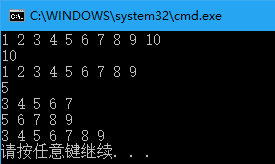一、定义
线性表是最基本、最简单、也是最常用的一种数据结构。线性表(linear list)是数据结构的一种,一个线性表是n个具有相同特性的数据元素的有限序列。
线性表中数据元素之间的关系是一对一的关系,即除了第一个和最后一个数据元素之外,其它数据元素都是首尾相接的(注意,这句话只适用大部分线性表,而不是全部。比如,循环链表逻辑层次上也是一种线性表(存储层次上属于链式存储),但是把最后一个数据元素的尾指针指向了首位结点)。
线性表(linear list)是数据结构的一种,一个线性表是n个具有相同特性的数据元素的有限序列。数据元素是一个抽象的符号,其具体含义在不同的情况下一般不同。
在稍复杂的线性表中,一个数据元素可由多个数据项(item)组成,此种情况下常把数据元素称为记录(record),含有大量记录的线性表又称文件(file)。
线性表中的个数n定义为线性表的长度,n=0时称为空表。在非空表中每个数据元素都有一个确定的位置,如用ai表示数据元素,则i称为数据元素ai在线性表中的位序。
线性表的相邻元素之间存在着序偶关系。如用(a1,…,ai-1,ai,ai+1,…,an)表示一个顺序表,则表中ai-1领先于ai,ai领先于ai+1,称ai-1是ai的直接前驱元素,ai+1是ai的直接后继元素。当i=1,2,…,n-1时,ai有且仅有一个直接后继,当i=2,3,…,n时,ai有且仅有一个直接前驱。
二、结点定义
#define LIST_INIT_SIZE 100
#define LISTINCREMENT 10
typedef int ElemType;
typedef ElemType Status;
typedef struct {
ElemType *elem;
int length; //当前已用
int listsize; //已分配
}SqList;三、具体操作的相关代码
1.SqList.h
#define LIST_INIT_SIZE 100
#define LISTINCREMENT 10
typedef int ElemType;
typedef ElemType Status;
typedef struct {
ElemType *elem;
int length; //当前已用
int listsize; //已分配
}SqList;
bool InitList_Sq(SqList &L);
bool ListInsert_Sq(SqList &L, int i, ElemType e);
bool ListDelete_Sq(SqList &L, int i, ElemType &e);
int ListLength_Sq(SqList &L);
int greater(ElemType argv1, ElemType argv2);
int less(ElemType argv1, ElemType argv2);
int equal(ElemType argv1, ElemType argv2);
void MergeList_Sq(SqList La, SqList Lb, SqList &Lc); //归并两个线性表中的元素,使其有序排列
int LocateElem_Sq( SqList &L, ElemType e, Status(*compare)(ElemType, ElemType) );
void Show_Sq(SqList &L);2.SqList.cpp
#include"SqList.h"
#include<stdio.h>
#include<stdlib.h>
bool InitList_Sq(SqList &L)
{
L.elem = (ElemType *)malloc(sizeof(ElemType)*LIST_INIT_SIZE);
if (!L.elem)
{
return false;
}
L.length = 0;
L.listsize = LIST_INIT_SIZE;
return true;
}
bool ListInsert_Sq(SqList &L, int i, ElemType e)
{
if (i<1 || i>L.length + 1) //5 2 7 4 6 3
{
return false;
}
if (L.length >= L.listsize)
{
ElemType *newbase = (ElemType*)realloc( L.elem, L.listsize + LISTINCREMENT*sizeof(ElemType) );
if (!newbase)
{
return false;
}
L.elem = newbase;
L.listsize += LISTINCREMENT;
}
ElemType*q = &(L.elem[i - 1]);
for (ElemType *p = &(L.elem[L.length - 1]); p >= q; --p)
{
*(p + 1) = *p; //前赋后
}
*q = e;
++L.length;
return true;
}
bool ListDelete_Sq(SqList &L, int i, ElemType &e)
{
if (i<1 || (i>L.length))
{
return false;
}
ElemType* p = &(L.elem[i - 1]); //5 2 7 4 6 3
e = *p;
ElemType* q = L.elem + L.length - 1; //末尾
for (++p; p <= q; ++p) //p指向第二个元素
{
*(p - 1) = *p; //后赋前
}
--L.length;
return true;
}
int greater(ElemType argv1, ElemType argv2) //大于
{
return argv1 > argv2;
}
int less(ElemType argv1, ElemType argv2) //小于
{
return argv1 < argv2;
}
int equal(ElemType argv1, ElemType argv2) //等于
{
return argv1 == argv2;
}
int ListLength_Sq(SqList &L)
{
return L.length;
}
void MergeList_Sq(SqList La, SqList Lb, SqList &Lc)
{
ElemType* pa = La.elem;
ElemType* pb = Lb.elem;
Lc.listsize = Lc.length = La.length + Lb.length;
ElemType* pc = Lc.elem = (ElemType*)malloc( Lc.listsize*sizeof(ElemType) );
if (!Lc.elem)
{
return;
}
ElemType* pa_last = La.elem + La.length - 1;
ElemType* pb_last = Lb.elem + Lb.length - 1;
while (pa <= pa_last && pb <= pb_last) //相同长度进行归并
{
if (*pa < *pb)
{
*pc++ = *pa++;
}
else if (*pa > *pb)
{
*pc++ = *pb++;
}
else
{
*pc++ = *pa++;
pb++;
--Lc.length;
}
}
while (pa <= pa_last)
{
*pc++ = *pa++;
}
while (pb <= pb_last)
{
*pc++ = *pb++;
}
}
int LocateElem_Sq(SqList &L, ElemType e, Status(*compare)(ElemType, ElemType))
//在线性表L中查找第1个值与e满足compare()的元素的位序
{
int i = 1;
ElemType* p = L.elem;
while ( i<=L.length && !(*compare)(*p++, e) )
{
++i;
}
if (i <= L.length)
{
return i;
}
else
{
return 0;
}
}
void Show_Sq(SqList &L)
{
if (NULL == L.elem)
{
return;
}
for (int i = 0; i < L.length; i++)
{
printf("%d ", L.elem[i]);
}
printf("\n");
}3.main.cpp
#include<stdio.h>
#include"SqList.h"
#include<stdlib.h>
#include<time.h>
int main()
{
SqList MySqList;
ElemType e;
InitList_Sq(MySqList);
for (int i = 1; i <= 10; i++)
{
ListInsert_Sq(MySqList, i, i);
}
Show_Sq(MySqList);
ListDelete_Sq(MySqList, 10, e);
printf("%d\n", e);
Show_Sq(MySqList);
int pos = LocateElem_Sq(MySqList, 5, equal);
printf("%d\n", pos);
SqList La;
InitList_Sq(La);
SqList Lb;
InitList_Sq(Lb);
SqList Lc;
InitList_Sq(Lc);
//srand( (unsigned)time(NULL) );
for (int i = 1; i <= 5; i++)
{
int a = i + 2;
ListInsert_Sq(La, i,a);
}
Show_Sq(La);
for (int i = 1; i <= 5; i++)
{
int b = i + 4;
ListInsert_Sq(Lb, i, b);
}
Show_Sq(Lb);
MergeList_Sq(La, Lb, Lc);
Show_Sq(Lc);
//此处缺少摧毁函数,有意者自行添加
}四、代码运行结果








 本文深入探讨线性表这一基本数据结构的概念、特点及应用。解析线性表中数据元素间的一对一关系,介绍结点定义与具体操作代码,包括初始化、插入、删除等关键函数,并展示代码运行结果。
本文深入探讨线性表这一基本数据结构的概念、特点及应用。解析线性表中数据元素间的一对一关系,介绍结点定义与具体操作代码,包括初始化、插入、删除等关键函数,并展示代码运行结果。

















 被折叠的 条评论
为什么被折叠?
被折叠的 条评论
为什么被折叠?








